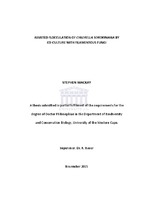Assisted flocculation of Chlorella Sorokiniana by co-culture with filamentous fungi
Abstract
Biofuel production from microalgae is currently not economically competitive with fossil fuels due to high operational costs. A sustainable system needs to be developed which considers cultivation, harvesting and conversion to fuels as a single loop. The harvesting step has been identified as a major bottleneck within the biofuel production process, contributing to a significant proportion of the operational cost (20-30%). Chemical flocculation is a more affordable alternative to centrifugation and filtration. Chemical flocculants however negatively impact the quality of biomass and conversion efficiency to biofuel by increasing biomass ash content. Bioflocculation with biopolymers or microbes have a minimal impact on the quality of biomass. In this study, the interaction between the filamentous fungus Isaria fumosorosea and the microalgae C. sorokiniana is investigated. Under strict autotrophic conditions at pH 7-8, co-culture of microalgae (2-20 μm) with fungal blastospores resulted in theidevelopment of large pellets (1-2 mm) which may be easily harvested by sedimentation or filtration at 95% harvesting efficiency. Fungal assisted bioflocculation was compared to other harvesting methods with respect to cost and impact on the hydrothermal conversion process. Low cost carbon sources, including waste hydrothermal nutrients, minimal sugar concentrations and algal exudate may reduce fungal cultivation costs. Waste products, such as organic carbon, N, P, CO₂ and trace metals can be recycled and used for algae and fungal cultivation, closing the loop to make the system sustainable.

